My favorite way to pick a new “Inside the Collections” topic is to stumble upon it—in this case, to come across it while housing new acquisitions in our storage facility. We have well over 20,000 objects in our museum collection, stored in seven rooms in three different buildings. Even after nine years at the Historical Society, I regularly “find” objects for the first time, or find a reason to reconsider an object I haven’t seen for some time. Sitting on one of the many shelves in our open storage area, I paused for a few seconds on two pieces of thin, pressed metal with obvious connections to England (see below). While they are clearly decorative, even so far as having evidence of a painted surface, I couldn’t immediately place their function. Too small to be an effective business sign, but too large to be a nameplate. The database told me they are “insurance signs.”
The more specific answer is that they are insurance markers. To be even more precise, fire insurance markers or, simply, fire marks.

